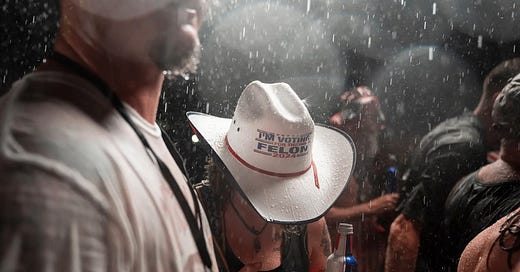Lately, rather than scrolling through Instagram, I’ve been finding a wellspring of photo inspiration in the pages of the morning paper (the New York Times). My digital journal, which I keep with the Zinnia app, has become a vision board of sorts for me—filled with photographs that resonate deeply. Every morning I find myself clipping photos from the Times and pasting them in my journal along with some words about why I am drawn to them. Two recent stories that stood out: one featuring divers navigating the waters of New York City, captured by Michael Turek, who in addition to photographs, made some Super 8 film clips, which add a cool and nostalgic layer to the narrative. The other story is a striking look at a MAGA music festival headlined by Kid Rock, with photos by Nicole Craine that brilliantly capture the feeling of the event.
As I fully immerse myself in documentary school photography, I find myself increasingly drawn to this kind of work from photojournalists - compelling images made in less-than-ideal conditions—spaces where the light is harsh or the environment is far from picturesque. I’m slowly training my Instagram feed away from family photography and towards grittier, more challenging subject matter, a reflection of the direction my work is taking.
Melissa Lyttle’s Substack recently showcased some of the best Olympic photography, and it was a goldmine of inspiration. Sports photography, which could easily become repetitive, is brought to life with such dynamism by the photographers she shared. I was particularly captivated by David Burnett’s use of the Holga, a low-fi camera that brought an unexpected texture to his photos. His images of politicians, captured with the same camera, are just as compelling. Burnett’s work is a masterclass in turning potentially mundane subjects into something extraordinary through a unique process. If you’re curious, you can explore his Holga work here and more of his portfolio here, along with a fascinating (though slightly dated) video of him discussing his gear (he now shoots Sony).
I’ve also been keeping an eye on Adam Pretty, whose Olympic swimming images are nothing short of magical,and Patrick Smith, who brings a fresh perspective with his unique compositions and crops.
When I interviewed for my current job, the COO expressed concern that I might not find school photography as artistically fulfilling as family portraits. But I argued that the real challenge for me in photography—and the real art—is in finding the extraordinary within the ordinary (and that can happen anywhere – whether it’s a family’s home, or a classroom).
I told her that Pete Souza, who spent eight years documenting President Obama’s time in office, is one of my favorite photographers, and he exemplifies this in his work. His book, Obama: An Intimate Portrait, is a testament to the power of framing, lighting, and capturing the right moment—all without the luxury of directing the subject. Souza’s work is a constant reminder that this kind of photography is, indeed, art.
Incidentally, I re-watched The Way I See It this morning, a documentary about Souza’s work. If you haven’t seen it, it’s worth your time. The sense of art as activism in Souza’s photography is something I deeply relate to in my work within public schools. There’s a feeling of advocacy and purpose that was missing in my previous work with families. This, to me, is what makes it meaningful—it’s about contributing to the greater good through visual storytelling.
In my quest for more books like Obama: An Intimate Portrait, I stumbled upon Manny Crisostomo’s A Class Act, which won the Pulitzer Prize for Feature Photography in 1989. Crisostomo spent a year documenting life at Southwestern High School in Detroit for the Detroit Free Press. How cool is that?—school photography winning a Pulitzer! The images are a remarkable glimpse into the life of a school, and I only wish there were a book version available; I’d buy it in a heartbeat.
Incidentally, if you have any recommendations for photobooks by photojournalists—especially those documenting smaller, local events—I’d love to hear them. I’m looking to add more to my collection. (I just went to grab a book to tell you about that I love, and is along these lines – called Main Street: A Portrait of Small-Town Michigan – which I found in a bargain bin of a used bookstore upstate – and just realized that it is by Manny Crisostomo!).
As I continue to explore the world of photojournalism, I’m reminded that the most powerful images often come from the most unexpected places, and that art can thrive in even the most challenging of circumstances. I’m eager to see where this inspiration will take me next and how it will shape the stories I tell through my lens.









All so interesting! I am so excited to see what you create and love your zinnia journaling!